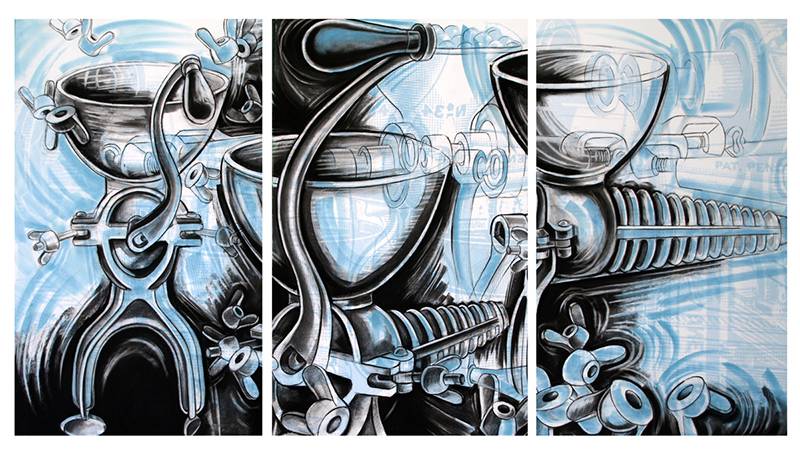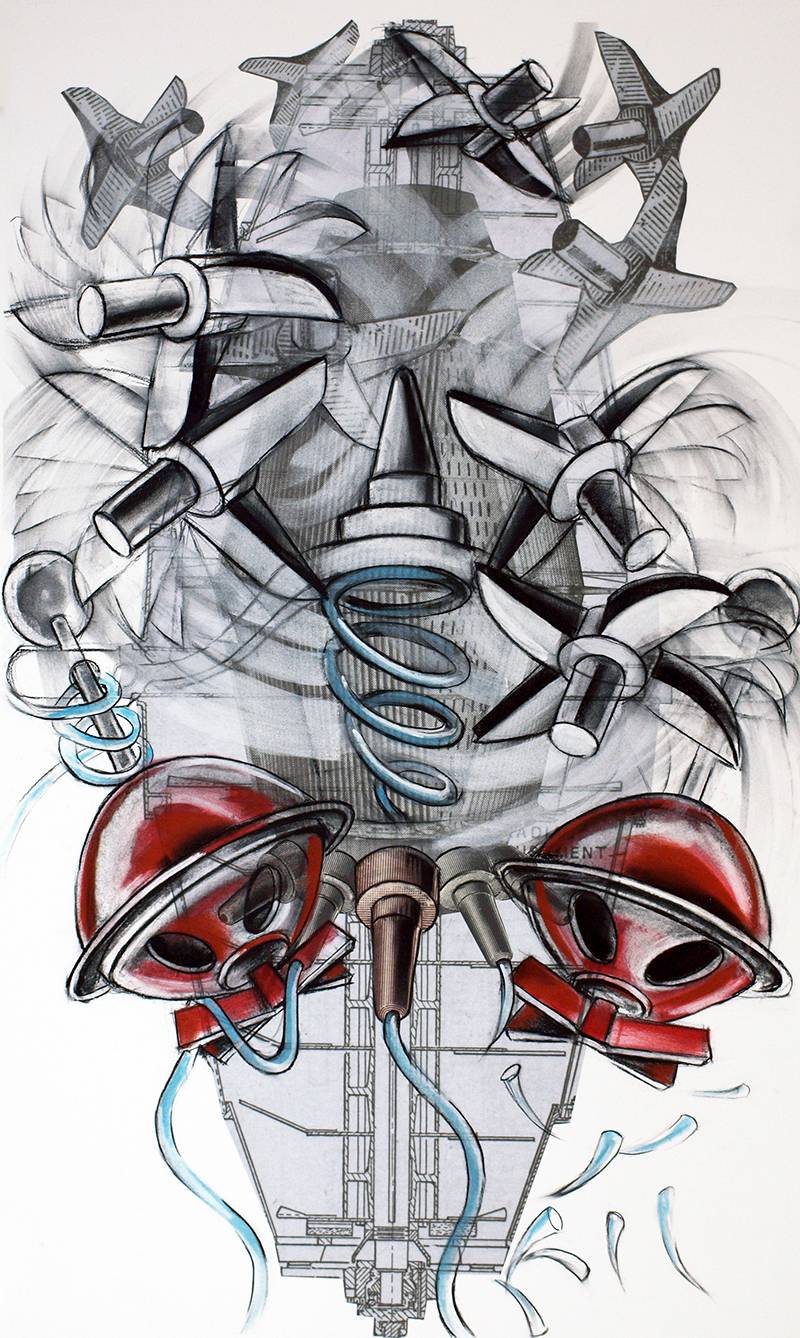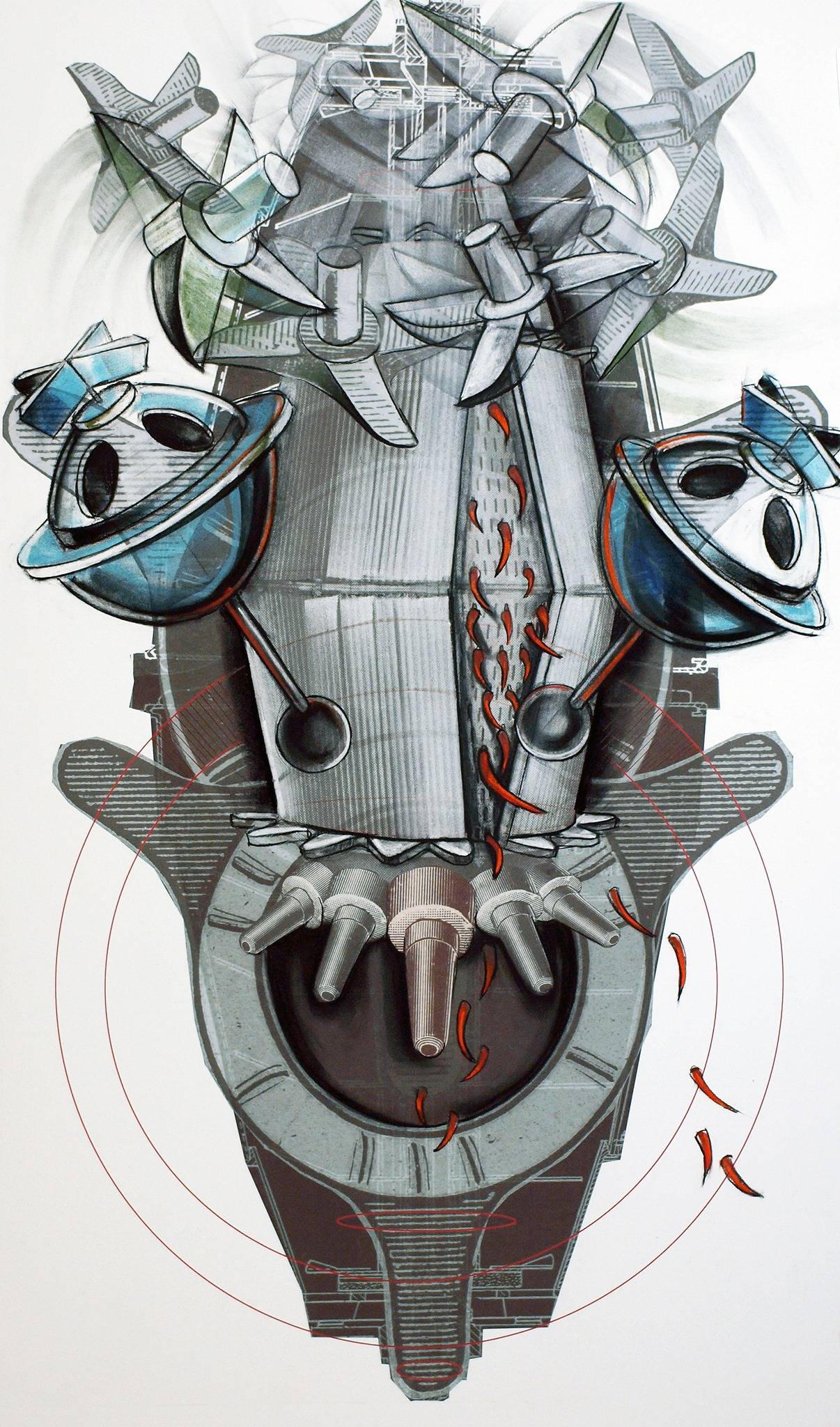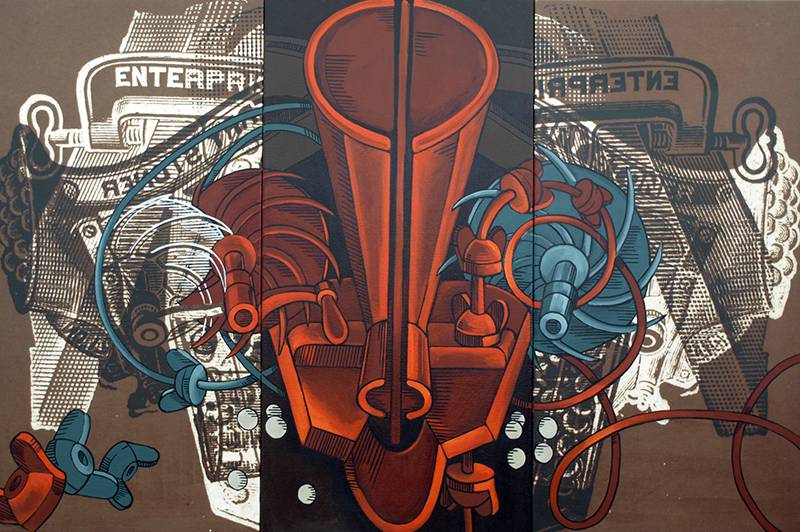From the first labor-saving devices pitched to American housewives, to medical devices, to the lastest smart home technology, our relationships to machines have long been as promising as they are problematic. In a consumer culture fueled by an addiction to novelty, progress yields obsolescence. And throughout this march of invention, we continue to redefine our selves and our roles in society.
For an artist like Jessica Gondek, whose series “Enterprising Machines” shows at Parkland College’s Giertz Gallery through November 2nd, these questions inform both subject and method. At the beginning of the month, I suggested you see “Enterprising Machines” in my list of must-see arts events for October 2019. Now, having experienced the exhibition (repleat with artist-led tour), observed viewers reactions to it, and given it additional research and consideration, I can safely say this is truly something to see. The work, and the important questions it raises, will stay with you long after you leave the Giertz Gallery.
Gondek is a conceptual artist, whose series reflect extensive research, historical and cultural references, and innovative mash-ups in both technique and subject. For this writer, the experience of “Enterprising Machines” was considerably enhanced by a bit of pre-visit research.
Pre-exhibition releases from the artiist shared that “Jessica Gondek “incorporates current technology using both hand and mechanical approaches to develop her work. Stemming from an interest in geometry, machine aesthetics, architecture, and nature, her recent body of work is sparked by machines from the early part of the twentieth-century, old trade catalogues, domestic utilitarian objects, Da Vinci’s inventions and war machines, Duchamp, and contemporary art movements. Marrying both traditional media and digitally mediated computer approaches to the work, she blurs the line of distinction between the hand and the machine.”
This is not to say that Gondek’s work has a singular, artist-approved meaning or message. Quite the contrary. Visual artists, unlike performing artists, do not typically experience regular feedback from their viewers. So I feel incredibly lucky to have witnessed a rare hour of audience-artist exhange.
Gondek began in the back of the gallery with the earlier works in this series where machines appear in the domestic landscape. In a recent essay on Gondek’s work, art historian Paula Wisotski observes the following.
“[Early on, the artist was” inspired by the early twentieth-century booklet The Enterprising Housekeeper published by the Philadelphia-based Enterprise Manufacturing Company in 1902. Masquerading as a cookbook aimed at women with helpful tips about food preparation and “200 tested recipes,” in reality the publication was a marketing tool for the hardware manufacturer’s domestic devices.”
As Gondek walked our group through these pieces, she noted that the use of paint for a deepr exploration of color, particularly as it relates to and challenges traditional gendering of domestic duties and domestic roles and responsibilities. Here simple irons are deconstructed and transformed into playful expressions of transparency and form.
Moving into the newer work in the series, the focus gradually shifted out of the domestic sphere, into the factory and beyond. These pieces, several of which are shown here in this review, employ a process as innovative and complexly layered as the questions they pose.

Wistoski’s comments on Gondek’s process note that “At one level her incorporation of materials from this period reinforces her connections to the artists whose examples have influenced her, yet, at the same time, her choices carry with them the patina of history and cannot escape a certain nostalgia owing to the relatively uncomplicated nature of the machines parts – for example, simple gear wheels and hand operated cranks — she has chosen to reproduce. This historical gulf is intensified by her manipulation of the source objects via computer-aided design and the digital printer; a process made possible by machines far more sophisticated than those elements depicted in the drawings themselves. Finishing the works with hand additions in charcoal and pastel, Gondek employs a range of artistic tools, commenting on the artist as intermediary between tradition and innovation.”
Towards the end of the tour, the group stood in front of the images above and below offering questions and impressions, taking stabs at possible inspiration in these half-figurative, half-impressionistic compositions.
Gondek layering techniques work towards creating a strong sense of movement. Several of us felt as if we could almost hear the whirring of the motors, the air moving through the blades and various cogs. Visually and perhaps even aurally these later pieces in the series achieve a symphonic resonace of conversations between old and new, outdated and re-imagined, masculine and feminine, motion and stillness.
As we reached the end of the tour, standing before the two works below, many of us sensed a merging of human and mechanic entities. The compositions themselves almost suggest figurative drawings. And the two together, shoulder to shoulder, were seen by some as alternative side views. For others the red suggested blood running through, animating the cold gray of the mechanics. Some saw suggestions of the female and male forms. Others saw the suggestion of a heart, perhaps the human spirit within the machine. Impromptu as it was, it was a fascinating group exercise in art appreciation.


As we were preparing to leave, Gondek thought more about the suggestions of hearts and lungs. She then shared that these pieces were developed shortly after the illness and death of her own father. A connection that seemed significant. As medical devices morph into implantable and even wearable tech, the lines between human and machine continue to blur. From irons to original iPhones, we continue to re-negotiate our identities and our roles in a culture of built-in obsilence that reveres novelty despite its costs.
Go experience this thought-provoking and extremely well-executed exhibition and consider Gondek’s technique and the larger notions it challenges.
Jessica Gondek: Enterprising Machines
Giertz Gallery
Parkland College
2400 W Bradley Ave, Champaign
September 30th through November 2nd
Photos courtesy of Giertz Gallery. Note: all images from this series included in this review are titled “Enterprising Machines”








